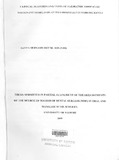| dc.description.abstract | Background: Orofacial malignant neoplasms are the sixth commonest malignancies in the world and together with cancer of the pharynx, they are the third most common malignancies in developing countries. While a few reports exist in the English literature, published studies specific on paediatric orofacial malignant neoplasms are scarce. In addition, most of these studies have been retrospective in nature and there is scanty information on the clinical features of these neoplasms at presentation.
Objective: To describe the clinical presentation and histopathologic types of orofacial malignant neoplasms in children.
Materials and Methods: A hospital-based cross-sectional study with a convenient sample of paediatric patients aged 15 years and below. A questionnaire and clinical examination form were used to record the data. The data were then coded and major trends described using the Statistical Package for Social Sciences (SPSS) 12.0 programme. Descriptive statistics included measures of central tendency and dispersion for continuous variables and proportions for categorical variables. Differences among dependent variables and independent variables were analysed using Pearson’s chi square test and/or Fisher’s exact test. A P- value of <0.05 was considered significant.
Results: The study included 65 children among whom 44(67.7%) were male and 21(32.3%) female. The age ranged from 0.25 years to 14 years with a mean of 5.3 years (± 3.4 SD). The main complaint was swelling 61(93.8%) followed by visual disturbance
29(44.6%). Overall, the mean duration of presenting symptoms ranged between 0.17- 36 months. Notably, and with the exception of retinoblastoma, the presentation of patients with sarcomas was relatively earlier than for carcinomas and lymphomas. The most frequent signs associated with the neoplasms were leucocoria 23(35.5%), proptosis 19(29.2%) and loss of vision 15(23.1%). The most common site was eye/orbit 30(46.2%), followed by the maxilla 11(16.9%) and other sites on the face 10(15.4%). A majority of the neoplasms were retinoblastoma (RTB) 26 (40%), followed by 14(21.5%) cases of Burkitt’s lymphoma (BL), 9(13.8%) of rhabdomyosarcoma (RMS), 6(9.2%) of non- Burkitt’s non- Hodgkin’s lymphoma (NB-NHL), 3(4.6%) of osteosarcoma (OS), 3(4.6%) of Kaposi’s sarcoma (KS), 2(3.1%) of squamous cell carcinoma (SCC), 1(1.5%) of fibrosarcoma (FS) and 1(1.5%) of nasopharyngeal carcinoma (NPC). Most neoplasms occurred in patients aged less than 5 years (40 cases) followed by 19 cases in children aged between 5 and 10 years. Only 2 infants were diagnosed with neoplasms.
Conclusions: Paediatric orofacial malignancies were more common in males than females except for RTB which was more common among female patients. Most of the malignancies were observed in the age group of 1-5 years. The clinical features of most paediatric orofacial malignant neoplasms depended mainly on the site of primary involvement with swelling having been the most common presenting complaint irrespective of tumour type. The most common sign was visual disturbance including leucocoria, loss of vision and proptosis. The commonest site of presentation was the orbital region and most neoplasms were advanced at the time of diagnosis. RTB
accounted for the majority of paediatric orofacial malignancies, followed by BL and RMS.
Recommendations: It is necessary to conduct population based studies targeting the different types of paediatric orofacial malignant neoplasms, especially R'l'B, to ascertain their exact incidence and prevalence in Kenya. There is also need to formulate strategies aimed at educating the public on the recognition of the clinical features of paediatric orofacial malignant neoplasms to ensure that early treatment is sought. In addition, research should be conducted to establish other reasons behind patient presentation with advanced disease to ensure prompt intervention so as to reduce morbidity and mortality. | en_US |
| dc.description.department | a
Department of Psychiatry, University of Nairobi, ; bDepartment of Mental Health, School of Medicine,
Moi University, Eldoret, Kenya | |

